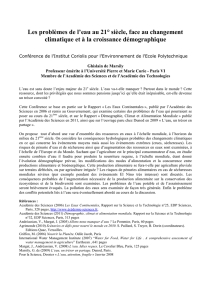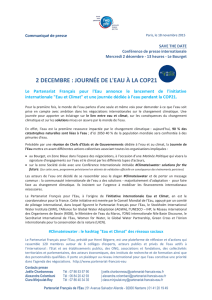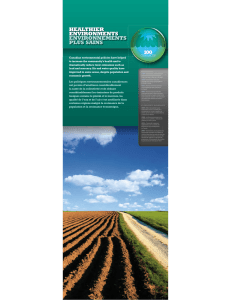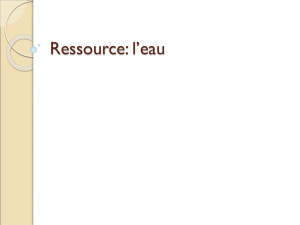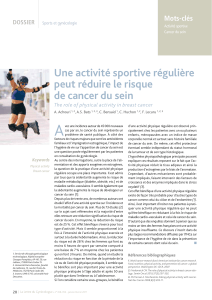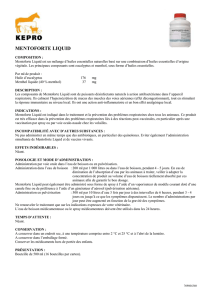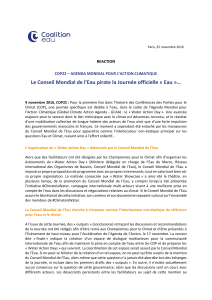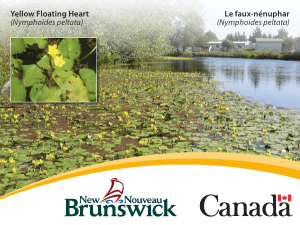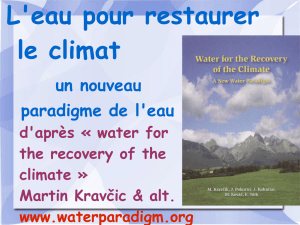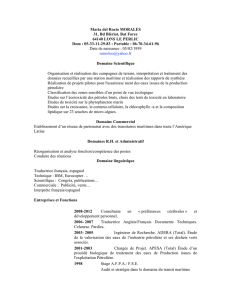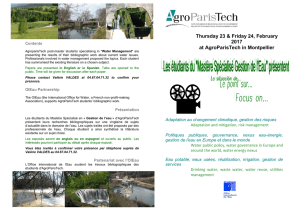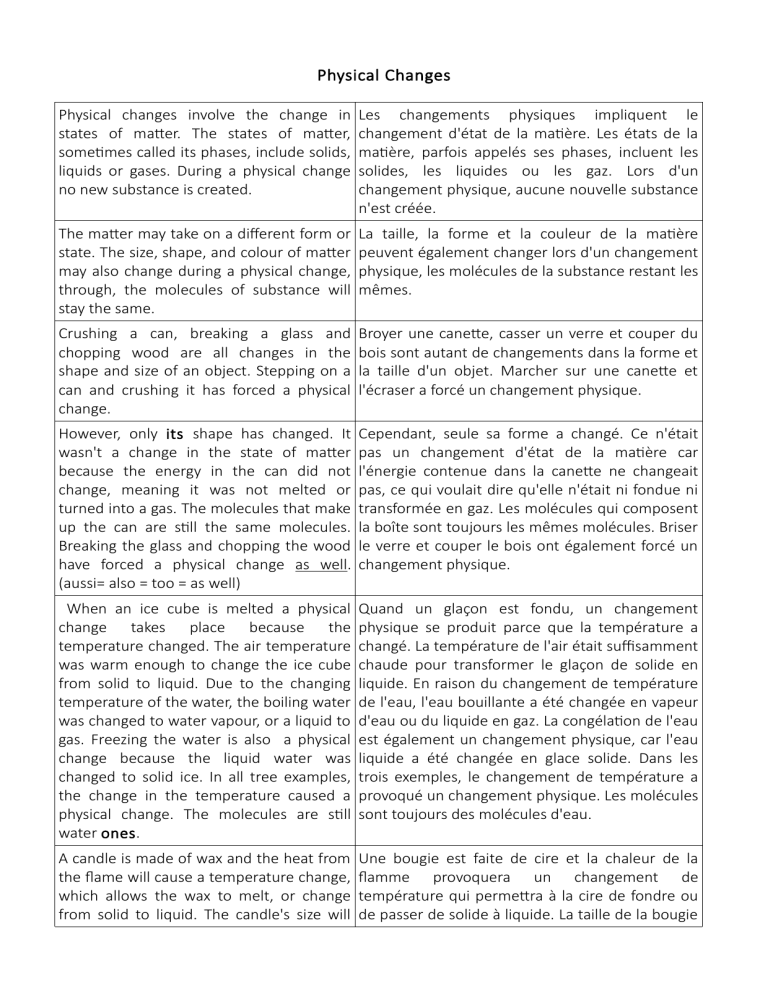
Physical Changes Physical changes involve the change in states of matter. The states of matter, sometimes called its phases, include solids, liquids or gases. During a physical change no new substance is created. Les changements physiques impliquent le changement d'état de la matière. Les états de la matière, parfois appelés ses phases, incluent les solides, les liquides ou les gaz. Lors d'un changement physique, aucune nouvelle substance n'est créée. The matter may take on a different form or state. The size, shape, and colour of matter may also change during a physical change, through, the molecules of substance will stay the same. La taille, la forme et la couleur de la matière peuvent également changer lors d'un changement physique, les molécules de la substance restant les mêmes. Crushing a can, breaking a glass and chopping wood are all changes in the shape and size of an object. Stepping on a can and crushing it has forced a physical change. Broyer une canette, casser un verre et couper du bois sont autant de changements dans la forme et la taille d'un objet. Marcher sur une canette et l'écraser a forcé un changement physique. However, only its shape has changed. It wasn't a change in the state of matter because the energy in the can did not change, meaning it was not melted or turned into a gas. The molecules that make up the can are still the same molecules. Breaking the glass and chopping the wood have forced a physical change as well. (aussi= also = too = as well) Cependant, seule sa forme a changé. Ce n'était pas un changement d'état de la matière car l'énergie contenue dans la canette ne changeait pas, ce qui voulait dire qu'elle n'était ni fondue ni transformée en gaz. Les molécules qui composent la boîte sont toujours les mêmes molécules. Briser le verre et couper le bois ont également forcé un changement physique. When an ice cube is melted a physical change takes place because the temperature changed. The air temperature was warm enough to change the ice cube from solid to liquid. Due to the changing temperature of the water, the boiling water was changed to water vapour, or a liquid to gas. Freezing the water is also a physical change because the liquid water was changed to solid ice. In all tree examples, the change in the temperature caused a physical change. The molecules are still water ones. Quand un glaçon est fondu, un changement physique se produit parce que la température a changé. La température de l'air était suffisamment chaude pour transformer le glaçon de solide en liquide. En raison du changement de température de l'eau, l'eau bouillante a été changée en vapeur d'eau ou du liquide en gaz. La congélation de l'eau est également un changement physique, car l'eau liquide a été changée en glace solide. Dans les trois exemples, le changement de température a provoqué un changement physique. Les molécules sont toujours des molécules d'eau. A candle is made of wax and the heat from the flame will cause a temperature change, which allows the wax to melt, or change from solid to liquid. The candle's size will Une bougie est faite de cire et la chaleur de la flamme provoquera un changement de température qui permettra à la cire de fondre ou de passer de solide à liquide. La taille de la bougie become smaller, and the shape will change, too. Glass is formed by the hardening of a substance, changing a liquid to a solid, another phase change. the shape and colour will also physical changes caused by the temperature change. When a person paints their house or fence, the paint being brushed onto the objects is a physical change because the colour of the fence has changed. In each of these examples, an object's size, shape, or colour was changed. All are examples of physical changes, deviendra plus petite et la forme changera également. Le verre est formé par le durcissement d'une substance, le changement d'un liquide en solide, un autre changement de phase. la forme et la couleur seront également des changements physiques causés par le changement de température. Lorsqu'une personne peint sa maison ou sa clôture, la peinture appliquée sur les objets constitue un changement physique, car la couleur de la clôture a changé. Dans chacun de ces exemples, la taille, la forme ou la couleur d'un objet a été modifiée. Tous sont des exemples de changements physiques, Evaporation happens when atoms or molecules escape from a liquid and turn into vapour. This is a physical change because the molecules of the matter change from a liquid to a gas. Evaporation can happen with any type of liquid. When temperatures as higher a liquid may evaporate faster. L'évaporation se produit lorsque des atomes ou des molécules s'échappent d'un liquide et se transforment en vapeur. Il s’agit d’un changement physique, car les molécules de la matière passent d’un liquide à un gaz. L'évaporation peut se produire avec n'importe quel type de liquide. à des températures aussi élevées, un liquide peut s'évaporer plus rapidement. When two or more substances are joined together without the molecules changing it is called a mixture. When different colours of candies are joined together it is an example of a mixture. None of the molecules of the candy change, so this is also a physical change. Water and sand is also mixture for the same reason. Lorsque deux substances ou plus sont jointes sans que les molécules changent, on parle de mélange. Lorsque différentes couleurs de bonbons sont assemblées, il s'agit d'un exemple de mélange. Aucune des molécules du bonbon ne change, il s'agit donc également d'un changement physique. L'eau et le sable sont également un mélange pour la même raison. Solutions are groups of molecules that are mixed together and evenly distributed in a substance. Powder milk is an examples because powder added to the water is spread out evenly throughout the water. the molecules of the liquid and the powder are joined together to create milk. Les solutions sont des groupes de molécules qui sont mélangés et répartis uniformément dans une substance. Le lait en poudre en est un exemple car la poudre ajoutée à l'eau est répartie uniformément dans l'eau. les molécules du liquide et de la poudre sont combinées pour créer du lait. COMPREHENSION TASKS I. Are these statements true or false? justify your answer. 1. Physical change create new substance. False (physical change no new substance is created.) 2. High temperature evaporates water, Ttue (When temperatures as higher a liquid may evaporate faster.) 3. A flame hardens wax. False (the wax to melt, or change from solid to liquid.) 4. A mixture is the result of changing molecules of two substances. False (When two or more substances are joined together without the molecules changing it is called a mixture.) II. Answer the questions : 1. What aspects of matter change do we call physical change? The aspects of material change that we call physical change are the change in shape, color, and size of it. 2. How does temperature affect water? The liquid water of the oceans is heated by the Sun it vaporizes in the air then liquefies taking altitude because the temperature decreases and will form clouds. Cloud water falls or solidifies at altitude to fall as snow and form ice on the mountains. The ice will gradually melt and flow into the earth or into rivers. The liquid water will then return to the sea and the cycle resumes. 3. What is the difference between a solution and a mixture? In a solution, substances are dissolved completely and they cannot be filtered out. Mixture contains two or more substances, which are not chemically combined. They only have physical interactions. 4. Can you state more examples of physical change? More examples of physical change: Crushing a can Écraser une canette Melting an ice cube Faire fondre un glaçon Mixing sand and water Mélange de sable et d'eau Breaking a glass Briser un verre Dissolving sugar and water Dissoudre du sucre et de l'eau Mixing salt and sand Couper une pomme Chopping wood Couper du bois Mixing red and green marbles Mélange de billes rouges et vertes Mixing flour, salt, and sugar Mélanger la farine, le sel et le sucre Crumpling a paper bag Froisser un sac en papier III. What do the underlined words refer to? Its : can Ones : molecules their : person This : Evaporation IV. Find in the text synonyms or antonyms of: 1. making something hard = Crushing a can, breaking a glass and chopping wood 2. thing # person 3. types V. Complete this paragraph with the right words: Water is known as the universal liquid because it dissolves more substances than any other solvent. It can do this because water molecules carry an electric charge strong enough to disrupt the molecules substances it dissolves - the solute. One such substance is (NaCl) sodium chloride, or table salt. When you put salt in water, the sodium and chlorine ions separate and attach themselves to individual water molecules. The resulting solution becomes an electrolyte, which means it's capable of conducting electricity. Dissolve table salt in water is a chemical change VI. summarise the text.
